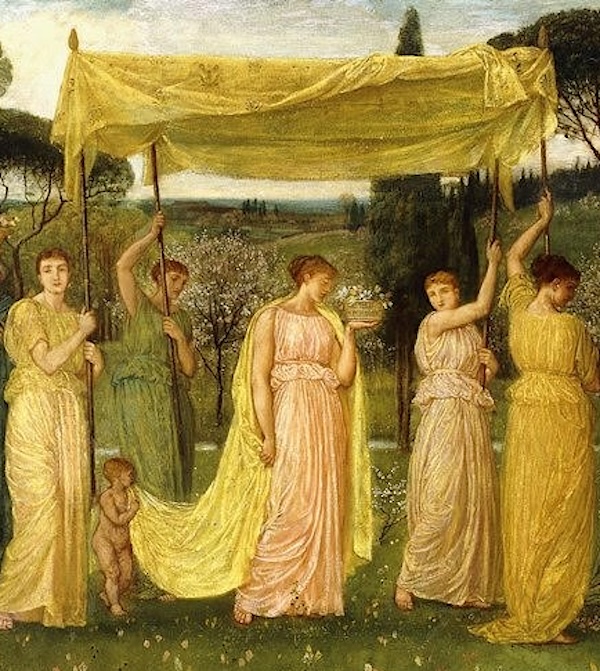
The Advent of Spring. 1873. Oil on canvas. 27 ¼ x 64 ½ inches (69.2 x 163.8 cm). Private collection. Image courtesy of Sotheby's. [Click on this image and the one below to enlarge them.]
The Advent of Spring, also known as The Coming of May, was painted in England in 1873 after Crane's return from Rome, having prolonged his honeymoon stay during the winter of 1872-73. Somerset Beaumont, an early patron of Crane, had commissioned the painting after seeing the artist working on the design of the Death of the Year. Beaumont admired this work, but finding it already spoken for, asked Crane to paint a similar processional subject for him on the artist's return to England.

Closer view of the canopied Spring and her maidens.
Crane recalled in his Reminiscences about this painting:
Spring appeared robed and crowned, her train held up by amorini, and she walked under a canopy supported by four maidens; before her were piping shepherds and nymphs dancing, and others trooped behind. At the end of the procession, which emerged from a wood, a figure cloaked in grey was shown seizing one of the nymphs and snatching flowers from her apron, suggesting a last assault of wintry weather. The green hilly landscape, interspersed with buildings and blossoming trees, was more or less founded on, or reminiscent of, some of my Roman studies. [155]
Although Crane does not specifically mention this, it is likely the painting was intended to relate to the pagan springtime fertility ritual of gathering wildflowers whose roots date back to ancient civilizations like the Greeks and Romans. The ritual, most notably associated with May Day, symbolized new life and was intended to ensure fertility for crops, livestock and mankind.
Crane obviously liked these processional paintings and had been influenced by similar works by English artists such as Frederic Leighton and William Blake Richmond. Crane had met Leighton in Rome during the winter of 1872. He had first seen such works by Leighton at the International Exhibition of 1862 where Cimabue's Madonna had been exhibited, the first of Leighton's processional pictures. Crane would have seen Leighton's The Syracusan Bride of 1865 at the annual Royal Academy summer exhibition. Such was the influence of Leighton on Crane's early work that Crane's sketch for The Death of the Year [Fitzwilliam Museum] was at one time thought to be by Leighton. Crane would have seen William Blake Richmond's The Procession of Bacchus at the Time of the Vintage at the Royal Academy exhibition in 1869.
Bibliography
19th Century European Paintings, Drawings, Watercolours and Sculptures. New York: Christie's (22 May 1991): lot 97.
19th Century European Paintings and Sculptures. New York: Sotheby's (26 May 1993): lot 91.
Crane, Walter. An Artist's Reminiscences. London: Methuen & Co., 1907, 149-50, 155.
Created 20 November 2025